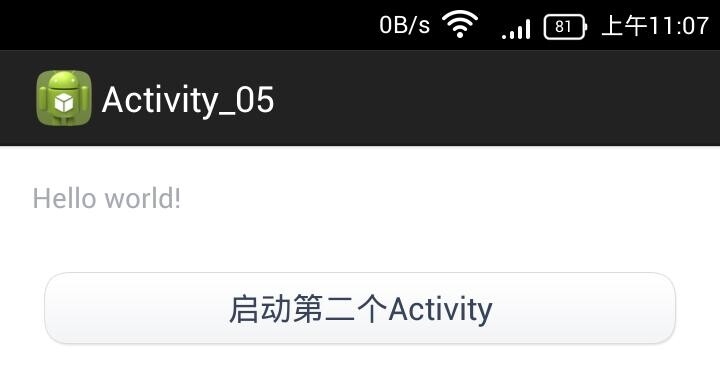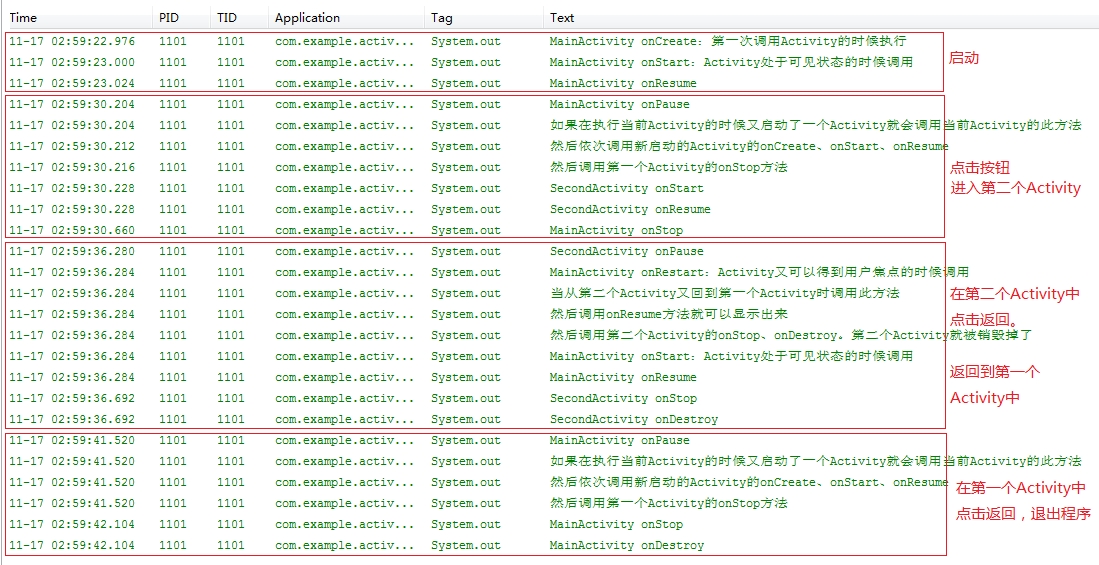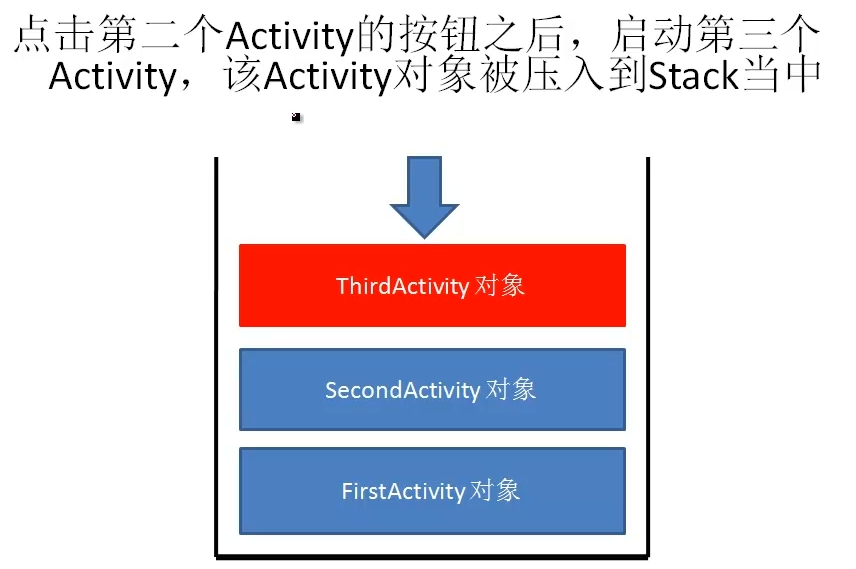|
1
2
3
4
5
6
7
8
9
10
11
12
13
14
15
16
17
18
19
20
21
22
23
24
25
|
<
RelativeLayout
xmlns:android
=
"http://schemas.android.com/apk/res/android"
xmlns:tools
=
"http://schemas.android.com/tools"
android:layout_width
=
"match_parent"
android:layout_height
=
"match_parent"
android:paddingBottom
=
"@dimen/activity_vertical_margin"
android:paddingLeft
=
"@dimen/activity_horizontal_margin"
android:paddingRight
=
"@dimen/activity_horizontal_margin"
android:paddingTop
=
"@dimen/activity_vertical_margin"
tools:context
=
"com.example.activity_05.MainActivity"
>
<
TextView
android:id
=
"@+id/textView1"
android:layout_width
=
"wrap_content"
android:layout_height
=
"wrap_content"
android:text
=
"@string/hello_world"
/>
<
Button
android:id
=
"@+id/button1"
android:layout_width
=
"fill_parent"
android:layout_height
=
"wrap_content"
android:layout_below
=
"@+id/textView1"
android:layout_marginTop
=
"22dp"
android:text
=
"启动第二个Activity"
/>
</
RelativeLayout
>
|
|
1
2
3
4
5
6
7
8
9
10
11
12
13
|
<?
xml
version
=
"1.0"
encoding
=
"utf-8"
?>
<
LinearLayout
xmlns:android
=
"http://schemas.android.com/apk/res/android"
android:layout_width
=
"match_parent"
android:layout_height
=
"match_parent"
android:orientation
=
"vertical"
>
<
TextView
android:id
=
"@+id/textView1"
android:layout_width
=
"fill_parent"
android:layout_height
=
"wrap_content"
android:text
=
"This is the second activity"
/>
</
LinearLayout
>
|
|
1
2
3
4
5
6
7
8
9
10
11
12
13
14
15
16
17
18
19
20
21
22
23
24
25
26
27
28
29
30
31
32
33
34
35
36
37
38
39
40
41
42
43
44
45
46
47
48
49
50
51
52
53
54
55
56
57
58
59
60
61
62
63
64
65
66
67
68
69
70
71
72
73
74
75
76
|
package
com.example.activity_05;
import
android.support.v7.app.ActionBarActivity;
import
android.content.Intent;
import
android.os.Bundle;
import
android.view.Menu;
import
android.view.MenuItem;
import
android.view.View;
import
android.widget.Button;
import
android.view.View.OnClickListener;
public
class
MainActivity
extends
ActionBarActivity {
private
Button button;
@Override
protected
void
onCreate(Bundle savedInstanceState) {
super
.onCreate(savedInstanceState);
System.out.println(
"MainActivity onCreate:第一次调用Activity的时候执行"
);
setContentView(R.layout.activity_main);
button = (Button) findViewById(R.id.button1);
button.setOnClickListener(
new
OnClickListener() {
@Override
public
void
onClick(View v) {
Intent intent =
new
Intent();
intent.setClass(MainActivity.
this
, SecondActivity.
class
);
MainActivity.
this
.startActivity(intent);
}
});
}
@Override
protected
void
onResume() {
System.out.println(
"MainActivity onResume"
);
super
.onResume();
}
//以上三个方法执行完毕之后这个Activity就可以使用了
@Override
protected
void
onStart() {
System.out.println(
"MainActivity onStart:Activity处于可见状态的时候调用"
);
super
.onStart();
}
@Override
protected
void
onRestart() {
System.out.println(
"MainActivity onRestart:Activity又可以得到用户焦点的时候调用"
);
System.out.println(
"当从第二个Activity又回到第一个Activity时调用此方法"
);
System.out.println(
"然后调用onResume方法就可以显示出来"
);
System.out.println(
"然后调用第二个Activity的onStop、onDestroy。第二个Activity就被销毁掉了"
);
super
.onRestart();
}
@Override
protected
void
onPause() {
System.out.println(
"MainActivity onPause"
);
System.out.println(
"如果在执行当前Activity的时候又启动了一个Activity就会调用当前Activity的此方法"
);
System.out.println(
"然后依次调用新启动的Activity的onCreate、onStart、onResume"
);
System.out.println(
"然后调用第一个Activity的onStop方法"
);
super
.onPause();
}
@Override
protected
void
onStop() {
System.out.println(
"MainActivity onStop"
);
//如果第二个Activity把第一个Activity完全遮挡住就调用这个函数
super
.onStop();
}
@Override
protected
void
onDestroy() {
System.out.println(
"MainActivity onDestroy"
);
super
.onDestroy();
}
}
|
|
1
2
3
4
5
6
7
8
9
10
11
12
13
14
15
16
17
18
19
20
21
22
23
24
25
26
27
28
29
30
31
32
33
34
35
36
37
38
39
40
41
42
43
44
45
46
47
48
|
package
com.example.activity_05;
import
android.app.Activity;
import
android.os.Bundle;
public
class
SecondActivity
extends
Activity {
@Override
protected
void
onCreate(Bundle savedInstanceState) {
super
.onCreate(savedInstanceState);
setContentView(R.layout.second);
}
@Override
protected
void
onStart() {
System.out.println(
"SecondActivity onStart"
);
super
.onStart();
}
@Override
protected
void
onRestart() {
System.out.println(
"SecondActivity onRestart"
);
super
.onRestart();
}
@Override
protected
void
onResume() {
System.out.println(
"SecondActivity onResume"
);
super
.onResume();
}
@Override
protected
void
onPause() {
System.out.println(
"SecondActivity onPause"
);
super
.onPause();
}
@Override
protected
void
onStop() {
System.out.println(
"SecondActivity onStop"
);
super
.onStop();
}
@Override
protected
void
onDestroy() {
System.out.println(
"SecondActivity onDestroy"
);
super
.onDestroy();
}
}
|
|
1
|
<
activity
android:name
=
".SecondActivity"
android:label
=
"第二个Activity"
/>
|
欢迎大家访问我的个人网站
萌萌的IT人




